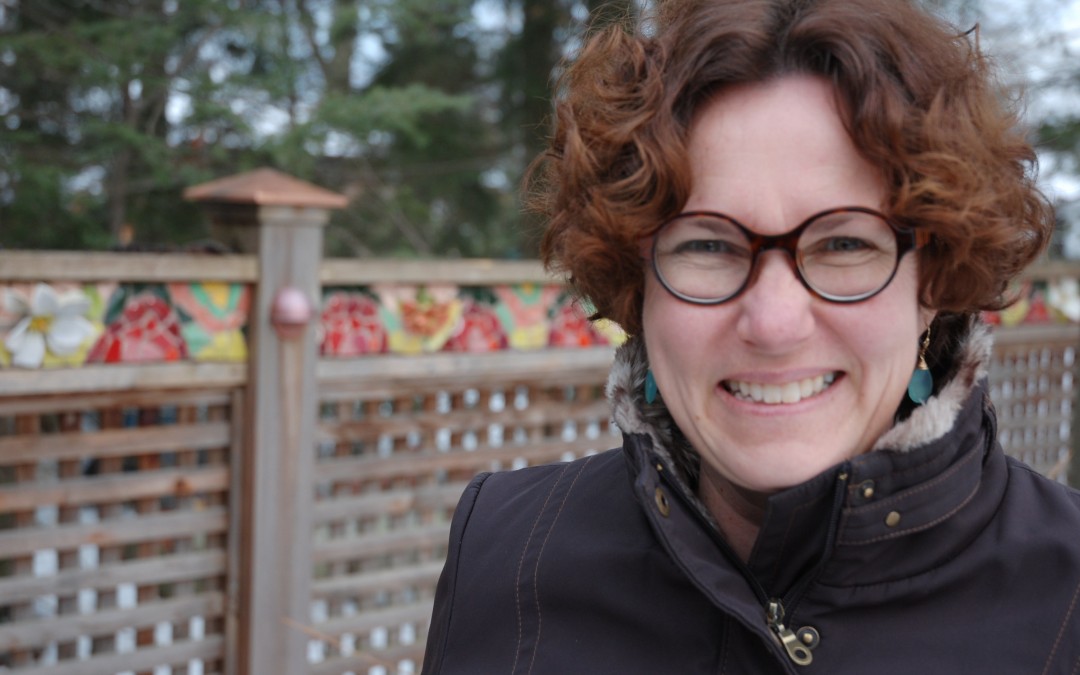An interview with Sue Riley by Anne de Groot
Interviewer:
Is there a piece of art that you most proud of and why?
Sue Riley:
I have two pieces.
Bathroom wall: The first piece that I am really proud of is a bathroom wall 7′ tall X 5′ wide. It was always such a boring bathroom. I had gotten these tumbled glass pieces from a glass artist and used them in a 4″ area above the shower and noticed that when the water hit them they came back to life, so I continued to the wall. I used a black background and combined orange, yellow, blue and lime green (tiles that I made myself). I didn’t use a pattern, but wanted some blobs on the wall. I made my own fused glass beads within the lime green tile blobs. The challenge was that the space was vertical and awkwardly situated. I really grew artistically when making this piece, which is what makes it so special.
Garden Fence: I went from that to mosaicing the top of my fence. One of the challenges I had was that I couldn’t just apply the mosaic to the particle board, as it would contract and expand with changes in the weather. I went to Home Depot and asked them what I could use and they suggested construction cement board, which is used when you stucco a house. I laid out the cut and sized cement board on my patio and flowed the mosaic through the various sections so it looked continuous. I have over 50 bins of china and I don’t always know what colours I’m going to use, so what inspired me was a bin of imperfect porcelain flowers which were given to me by another artist. I had trilliums, blue bells, pointsiettas, poppies, etc., which gave me an idea of the colour scheme I would use to compliment the flowers. I readjusted the pattern several times, as I ran out of colours and had to substitute others. The whole fence took one summer to complete and combined my two passions of gardening and making mosaics.
Interviewer:
Why did you start to make your mosaic art?
Sue Riley:
I’ve always been attracted to colour and patterns, I used to do stained glass, traditional rug hooking, embroidery and I love to do puzzles. I took a patio stone mosaic workshop and then I saw an article where this lady did a fireplace surround, where she used china, dolls faces, and I thought, I really want to do that.
People ask me if I get my materials from garage sales, there isn’t enough. Ironically in 1999, I met a gal at a garage sale who dealt in discontinued china patterns. She became my supplier with cracked and broken pieces she couldn’t sell. People ask me if I smash up the plates, but I don’t. I hand cut every single piece, if the piece has a picture I reassemble it like a puzzle, so you can tell what it is. That way I don’t get a lot of waste, and I keep what I want to keep of the piece.
Question:
How do you know when a piece that you are working on is finished?
Sue Riley:
I keep cleaning it until it is polished and the grout is uniform and it just looks finished to me. I’ve got to feel like this is something I would want before it is finished, it’s got to sparkle and be brought back to life. It starts off all broken and I then I reassemble it too make something new again.
Interviewer:
What inspires you?
Sue Riley:
Taking something that someone just discards and is broken and re-imagining it as something else.
Interviewer:
What is your most important artistic tool and is there something you cannot live without in your studio?
Sue Riley:
One of my most important tools is a popsicle stick. When I first started out I was using a wet cloth, but noticed it was taking out too much of the grout, so I started using a popsicle stick to take the grout off each individual piece. If you have glazed china, the glaze acts as a repellant, for the grout, so the grout will not stick to a glazed surfaces like china and glass, but will stick to a porous surface. That is why I do not use earthenware. I have a different technique for shells or porous pieces.
Two tools I can’t live without are my hand-cutters and a painter’s palette knife. The hand-cutters have two little wheels on them which allow me to work with finer pieces and I have more control of how it is going to cut. I use the painter’s palette knife to apply my mastic (adhesive). It’s called “buttering”. I use the point to scrape off what I don’t need and I use the edge to take the adhesive out of the cracks. The palette knife is not an essential tool; I could easily use a popsicle stick, but it’s a lot quicker if you have a tool with an edge to it.
You can contact Sue directly at suething@sympatico.ca to see her work.




